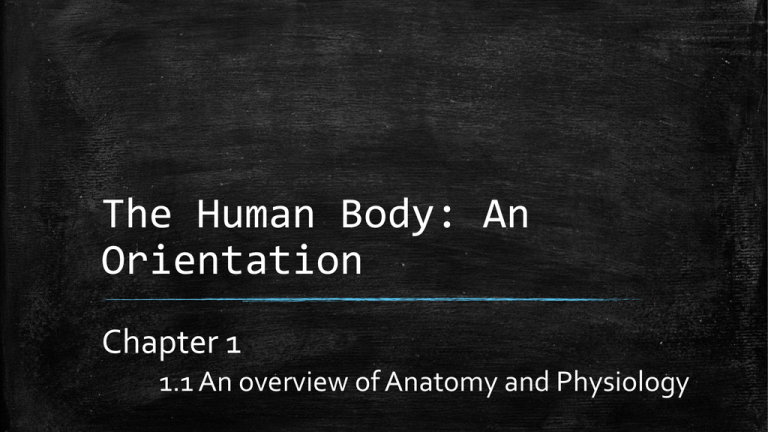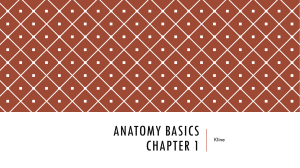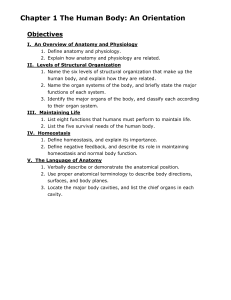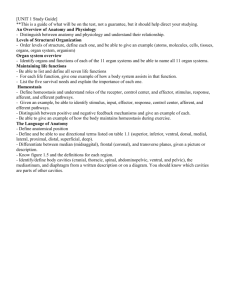Chapter 1.1 PowerPoint No answers
advertisement

The Human Body: An Orientation Chapter 1 1.1 An overview of Anatomy and Physiology Bellwork 1. In your own words define – Anatomy – Physiology 2. Which body system are you most interested in and why? 2 The Human Body ▪ Vocabulary • Anatomy: The study of the structure and shape of the body and its parts • Physiology: The study of how the body and its parts work or function • Metabolism: All chemical reactions in the body • Homeostasis: Systems maintain a relative constant or balanced internal environment 3 The Human Body – Pick a structure on your body, describe it’s anatomy(structure) & physiology(function) – Example: ARM (don’t use arm) ▪ Anatomy: made of muscles, bones, nerves, blood vessels ▪ Physiology: Used to throw, swing a bat, climb 4 Levels of Organization ▪ Vocabulary • Chemical Level: Atoms which join as molecules • Common Elements: H, O, N, Ca, Na, K • Cellular Level: Atoms and molecules form functional units • Smallest living units in the body 5 Levels of Organization ▪ Vocabulary • Tissue Level: Groups of cells that work together to perform a function • 4 Types of tissues: Epithelial, nervous, connective, muscular • Organ Level: Tissues join together to form a structure, with a recognizable shape and has specific functions • Examples: Stomach, heart, brain, liver, lungs 6 Levels of Organization Organ Level • In your notebook or your notetaker pick an organ, draw and color it, and then write 2 sentences on the function of that organ. 7 Levels of Organization ▪ Vocabulary • System Level: Organs and tissues that have a common purpose and function for the body • There are 11 principal systems in the human body • Organism Level: Largest level of organization • Chemicals—Cells—Tissues—Organs—Systems—Organism 8 Levels of Organization (Systems) ▪ Integumentary System (Skin) • Regulates body temperature • Protection • Receives stimuli • Organs: • Skin, Hair, Nails 9 Levels of Organization ▪ Skeletal System • Protects and supports body organs • Stores minerals • Provides muscle attachment for movement • Organs: • Bones, Cartilage, Joints 10 Levels of Organization ▪ Muscular System • Brings about body movements • Maintains posture • Produces body heat • Organs • Skeletal, Cardiac and Smooth muscle 11 Levels of Organization ▪ Nervous System • Regulates body activities through nerve impulses • Organs: • Brain, Spinal Cord, Nerves, Sensory Organs 12 Levels of Organization ▪ Endocrine System • Regulates body activities through hormones • Organs: • Gland (thyroid, pituitary, adrenal, etc.) 13 Levels of Organization ▪ Cardiovascular System • Transports oxygen and nutrients to the body • Removes carbon dioxide from the body cells • Organs: • Blood, Blood Vessels, Heart 14 Levels of Organization ▪ Lymphatic System • Involved in immunity • Filters blood • Organs: • Lymph nodes, Spleen, Tonsils 15 Levels of Organization ▪ Respiratory System • Supplies oxygen, removes carbon dioxide and regulates acid-base balance • Organs: • Lungs, Alveoli, Conducting Passageways 16 Levels of Organization ▪ Digestive System • Break down of food • Allows for nutrient absorption into the blood • Eliminates indigestible material • Organs: • Mouth, stomach, intestines, esophagus 17 Levels of Organization ▪ Urinary System • Produces and stores urine • Maintains electrolyte balance • Regulates water volume • Organs: • Kidneys, bladder, ureters, urethra 18 Levels of Organization ▪ Reproductive System • Production of sperm or oocytes • Production of offspring • Organs: • Testes, ovaries, penis, vagina 19 Levels of Organization ▪ Review • I’m gonna put you in groups of 4, using the slates you’ll answer the following questions • Pay attention, you might see these questions again(hint, hint) 20 Levels of Organization A: Chemical B: Cellular E: System F: Organismal H: Physiology C: Tissue I: Homeostasis D: Organ G: Anatomy J: Metabolism 1. ________ Tissues join together to form a body structure 21 Levels of Organization A: Chemical B: Cellular E: System F: Organismal H: Physiology C: Tissue I: Homeostasis D: Organ G: Anatomy J: Metabolism 2. ________ Systems maintain a relative constant or balanced internal environment 22 Levels of Organization A: Chemical B: Cellular E: System F: Organismal H: Physiology C: Tissue I: Homeostasis D: Organ G: Anatomy J: Metabolism 3. ________ Includes oxygen, carbon, calcium, etc. in simplest form 23 Levels of Organization A: Chemical B: Cellular E: System F: Organismal H: Physiology C: Tissue I: Homeostasis D: Organ G: Anatomy J: Metabolism 4. ________ The largest level of organization 24 Levels of Organization A: Chemical B: Cellular E: System F: Organismal H: Physiology C: Tissue I: Homeostasis D: Organ G: Anatomy J: Metabolism 5. ________ The study of how the body and its parts work or function 25 Levels of Organization A: Chemical B: Cellular E: System F: Organismal H: Physiology C: Tissue I: Homeostasis D: Organ G: Anatomy J: Metabolism 6. ________ Made of organs and tissues that have a common function and result 26 Levels of Organization A: Chemical B: Cellular E: System F: Organismal H: Physiology C: Tissue I: Homeostasis D: Organ G: Anatomy J: Metabolism 7. ________ All chemical reactions in the body 27 Levels of Organization A: Chemical B: Cellular E: System F: Organismal H: Physiology C: Tissue I: Homeostasis D: Organ G: Anatomy J: Metabolism 8. ________ Basic structure and function units, the smallest living units in the body 28 Levels of Organization A: Chemical B: Cellular E: System F: Organismal H: Physiology C: Tissue I: Homeostasis D: Organ G: Anatomy J: Metabolism 9. ________ Includes muscle, bone and nerve, epithelial, and connective; makes up organs and other parts 29 Levels of Organization A: Chemical B: Cellular E: System F: Organismal H: Physiology C: Tissue I: Homeostasis D: Organ G: Anatomy J: Metabolism 10. ________ The science of the structure and shape of the body and its parts 30







